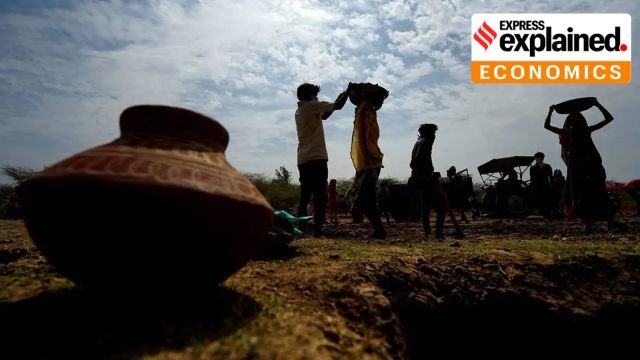Revisiting NREGA Wage Rates: A Case for Urgent Reform

- 12 Apr 2025
In News:
The Mahatma Gandhi National Rural Employment Guarantee Act (MGNREGA) is the world’s largest public employment programme, aimed at ensuring livelihood security through guaranteed rural employment. However, a recent report by the Parliamentary Standing Committee on Rural Development and Panchayati Raj (April 2025) underscores a critical challenge: the wage rates under MGNREGA are increasingly inadequate, failing to provide even subsistence-level income.
With over 25 crore registered workers, the scheme is central to rural welfare. Yet, its effectiveness is diluted due to systemic underpayment. For FY 2025–26, MGNREGA wages vary from ?241 in Nagaland to ?400 in Haryana, averaging only ?294 nationally—a meagre 5% increase from the previous year. In many states, this rate is significantly lower than the prevailing minimum wage, in some cases by over ?200, raising serious questions about wage fairness and constitutional obligations.
Legal and Policy Background
Section 6 of the MGNREGA Act permits the Centre to fix wage rates independently of the Minimum Wages Act, 1948, though the wage cannot be below ?60. Historically, from 2005 to 2009, NREGA wages matched each state’s minimum agricultural wage. However, the Centre capped NREGA wages at ?100 in 2009 due to financial concerns, leading to payments falling below statutory minimum wages—a move that the Karnataka High Court (2011) and Supreme Court (2012) found violative of labour rights.
In response to mounting concerns, wage indexation to the Consumer Price Index for Agricultural Labourers (CPI-AL) began in FY 2011–12, with 2009 as the base year. Nevertheless, CPI-AL is narrow in scope compared to CPI-Rural (CPI-R), which better reflects the cost of living for rural workers across sectors.
Ignored Recommendations and Institutional Apathy
Several expert bodies have urged wage revisions. The Jean Dreze Committee (2010) advocated aligning NREGA wages with state minimum wages or, at the very least, indexing them effectively. The Mahendra Dev Committee (2014) recommended CPI-R-based indexing with an updated base year, while the Anoop Satpathy Committee (2019) proposed a national floor wage of ?375 (at July 2018 prices). However, the Centre has largely disregarded these suggestions, citing fiscal constraints.
Only a few states, including Odisha and Himachal Pradesh, have supplemented NREGA wages from their own budgets. Most continue with the Centre’s insufficient rates, causing regional disparities and undermining the constitutional promise of equal pay for equal work (Article 39).
Need for Course Correction
The current wage structure risks violating Article 23 of the Constitution, as flagged in the Supreme Court’s 1983 Sanjit Roy vs State of Rajasthan verdict, which held that paying less than the minimum wage constitutes “forced labour.”
Moreover, stagnant wages have contributed to declining worker participation. The Standing Committee rightly argues that current wages do not meet basic daily expenses and recommends a minimum daily wage of ?400. Without wage parity and realistic indexation, the scheme fails to uphold its foundational promise of dignified rural employment.
Conclusion
MGNREGA is more than a welfare scheme—it is a statutory right. To realize its full potential in promoting rural livelihoods and inclusive growth, wage reforms are imperative. Revising NREGA wages to reflect minimum wage laws, inflation trends, and regional parity is not just an economic necessity—it is a constitutional obligation.
